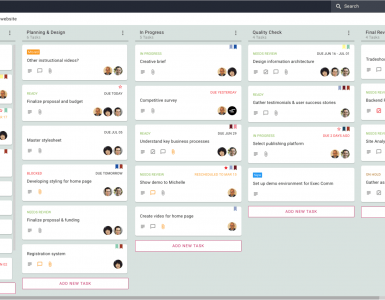Freelancing is a great career path for anyone who wants to live an independent life, working for themselves.
It’s one of the most sought-after remote jobs, where you can work from wherever you want. There’s no bar to the amount of money you can earn because it depends on your capacity to take projects, skills, and experience. However, a lot of freelancers struggle with signing high-paying projects.
A must-have skill for every freelancer to sign high-ticket clients is negotiation. Learning to negotiate your rates with clients can ensure you sign more projects faster and at a profitable price.
In this article, we’ll talk about some tips to negotiate with your clients the right way to crack the deal and earn more money. By the end of it, you will have some ideas for creating a negotiation strategy to position yourself as a valuable resource to help businesses grow.
Let’s get started:
1. Communicate The Value You’re Providing
Before you negotiate your prices, it’s essential to explain the value you’re bringing to the table. Often, a prospect who’s hiring you for your services may not be aware of your working processes.
Your prospects may not know about the behind-the-scenes-action that leads to the outcome. This can be one reason why they’re not willing to pay what you quote and want to negotiate. Once you involve them in the process and communicate the value you’re providing, they may understand and justify your prices better.
You can explain them through case studies on your blog or a client testimonial.
Understandably not everyone knows the work you do and the results it brings.
Communicating is the best way to ensure you’re maintaining transparency and being paid for the work you put into the project.
So, before you negotiate your prices, talk to your client about your services, and why you’re charging what you’re charging. This will help them understand your perspective, and might even scrap out the scope for negotiation altogether.
With pricing, more than the quote, the value is at play. Your prospects may feel that the value they’re getting from your services is not equivalent to the price they’re paying. Once you tell them the processes and the work that goes behind achieving the outcome, they will understand the value. Those who understand it will pay for your services, even if it means going a little beyond their budget if they know the value they’re getting out of it.
2. Determine Your Minimum Acceptable Rate (MAR)
Your minimum acceptable rate is a price quotient you should never go below while negotiating with your prospects. It is a combination of your expenses, taxes, and years of experience that determines the minimum rate you must charge.
You can use this formula to determine your MAR:
Personal expenses + professional expenses/numbers of hours you work
Over this, you can add your taxes. However, this figure is not what you should charge as the MAR because this is your expense profile. You also need to consider your skills and working experience, so always have a MAR higher than this price.
This MAR figure is based on the hourly model. If you plan to charge per project, then you can have a separate one for that.
You will calculate your MAR based on your current life situations. Over time, this will increase as you move ahead in life, and your quality of life or circumstances requires higher expenses. Whatever it is, always calculate your MAR, so you’re not going below it even after negotiating.
3. Quote Higher Than Your Standard Rate (To Maintain A Wiggle Room)
There is a common myth among freelancers that qualified leads don’t negotiate.
That’s not true because everyone has a budget based on where they are in their business. It’s not a bad thing to negotiate. However, you should know how to negotiate in your favor.
Having a rate card is one of the most feasible things for a freelancer. It prevents constant back and forth when someone asks you for your rate. Ideally, when you’re talking to a prospect, quote a higher price than your standard rate.
When you do, even if they negotiate, they’ll come back to your standard rate, which is fair pricing for you. This is a win-win situation because when this happens, your prospect will feel that they’ve achieved something by negotiating and bringing down the price while you’ll be working at your standard rate.
However, remember not to quote an unrealistic price. You can go 10% higher. If they reject you at this rate, they would probably not go ahead with you, even at your standard price.
The idea is to give yourself some wiggle room so you can negotiate and still have the pricing in your favor. Negotiating too much or working below your standard rate is not fair. It takes away all the motivation to work and is not healthy for long-term professional relationships.
This way even if the scope of the project ends up taking more time or costing more money you are still able to get a fair rate for yourself as profit. When you offer writing, video production, screenshare product videos, or design services this can be a huge deciding factor for how much profit you make per client project.
4. Learn To Say ‘No’
Just because negotiation is an option to close the client, it doesn’t mean that you work with every prospect that comes your way. You must decide when it’s time to say ‘no’ and move ahead.
If the client cannot meet your minimum rate, is negotiating a lot and you see too many red flags that force you to second-guess working with them, you must say ‘no.’
As a freelancer, you can choose to charge the way you want. The clients don’t determine your rate; they only decide whether they want to work with you.
So, use it to your advantage and decline projects which don’t meet your pricing. There are plenty of other clients who will value your work and pay your rates without thinking twice.
When you’re not getting a lot of projects, it may seem tempting to take up low-paying projects or even negotiate a lower price, but try avoiding that. In such times, you may feel everything is going wrong but you need to wait it out.
Patience and persistence are must-haves as a freelancer.
5. Offer A Small Discount For The First Month
Another way to close a deal is to offer a small discount, say 10% for the first month to build trust with your client. You can tell them you’re offering a discount only for the first month of your contract so they can see how you work, and the assistance you provide throughout the project.
This way, they’ll get to see what you’re truly worth, and if they like your work in the 1st month, they can take it forward at the original price from the next month onwards.
This is great for projects which have the potential of turning into long-term retainers. It’s beneficial for the client to get an exclusive discounted rate and for you, as you’ll sign a long-term contract at an original price.
Ensure that you mention the original price in your contract and invoice, and offer a discount over that. This will remind them of your original pricing and will also help in contract management.
6. Don’t Compromise Your Value For A Project
Lastly, remember to not compromise on your value as a freelancer and service-provider for a project. Charging lower than what you’re worth is much worse than not working on projects at all because this way, you’re not getting paid properly but are investing your time and energy into working for them.
Instead of this, have patience, and work towards improving your skills, and getting more clients. Time spent working on projects that don’t pay you accurately can be used effectively in marketing your services, so you get high-ticket clients who pay you for what you’re worth.
As a freelancer, you can choose to work with as many clients as you want, but you can negotiate only to an extent. Beyond that, you must draw a line and be firm about your pricing.
Only then will you get past these clients that don’t value you to reach clients who can’t wait to start working with you.
Wrapping Up
Freelancing is a partnership of mutual benefit. If you’re providing your services and they’re enjoying the outcome, you have a right to earn for the service you’re offering. Negotiation is a great way to work with clients, and these tips will surely help you get ahead in the game.
If you want to earn more as a successful freelancer and spend less time explaining your pricing structure, hone negotiation skills. It’s one of the most profitable skills for a freelancer.










